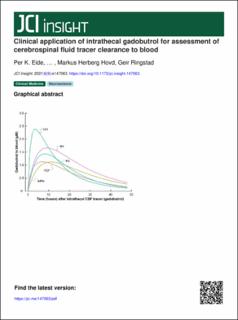| dc.contributor.author | Eide, Per Kristian | |
| dc.contributor.author | Mariussen, Espen | |
| dc.contributor.author | Uggerud, Hilde Thelle | |
| dc.contributor.author | Pripp, Are Hugo | |
| dc.contributor.author | Lashkarivand, Aslan | |
| dc.contributor.author | Hassel, Bjørnar | |
| dc.contributor.author | Christensen, Hege Staaland | |
| dc.contributor.author | Hovd, Markus Herberg | |
| dc.contributor.author | Ringstad, Geir Andre | |
| dc.date.accessioned | 2021-05-28T07:26:00Z | |
| dc.date.available | 2021-05-28T07:26:00Z | |
| dc.date.created | 2021-05-18T14:08:42Z | |
| dc.date.issued | 2021 | |
| dc.identifier.citation | JCI insight. 2021, 6, e147063. | en_US |
| dc.identifier.issn | 2379-3708 | |
| dc.identifier.uri | https://hdl.handle.net/11250/2756753 | |
| dc.description.abstract | BACKGROUND. Methodology for estimation of cerebrospinal fluid (CSF) tracer clearance could have wide clinical application in predicting excretion of intrathecal drugs and metabolic solutes from brain metabolism and for diagnostic workup of CSF disturbances.
METHODS. The MRI contrast agent gadobutrol (Gadovist) was used as a CSF tracer and injected into the lumbar CSF. Gadobutrol is contained outside blood vessels of the CNS and is eliminated along extravascular pathways, analogous to many CNS metabolites and intrathecal drugs. Tracer enrichment was verified and assessed in CSF by MRI at the level of the cisterna magna in parallel with obtaining blood samples through 48 hours.
RESULTS. In a reference patient cohort (n = 29), both enrichment within CSF and blood coincided in time. Blood concentration profiles of gadobutrol through 48 hours varied between patients diagnosed with CSF leakage (n = 4), idiopathic normal pressure hydrocephalus dementia (n = 7), pineal cysts (n = 8), and idiopathic intracranial hypertension (n = 4).
CONCLUSION. Assessment of CSF tracer clearance is clinically feasible and may provide a way to predict extravascular clearance of intrathecal drugs and endogenous metabolites from the CNS. The peak concentration in blood (at about 10 hours) was preceded by far peak tracer enhancement at MRI in extracranial lymphatic structures (at about 24 hours), as shown in previous studies, indicating a major role of the spinal canal in CSF clearance capacity.
FUNDING. The work was supported by the Department of Neurosurgery, Oslo University Hospital; the Norwegian Institute for Air Research; and the University of Oslo. | en_US |
| dc.language.iso | eng | en_US |
| dc.rights | Navngivelse 4.0 Internasjonal | * |
| dc.rights.uri | http://creativecommons.org/licenses/by/4.0/deed.no | * |
| dc.title | Clinical application of intrathecal gadobutrol for assessment ofcerebrospinal fluid tracer clearance to blood | en_US |
| dc.type | Peer reviewed | en_US |
| dc.type | Journal article | en_US |
| dc.description.version | publishedVersion | en_US |
| dc.rights.holder | © 2021, Eide et al. | en_US |
| dc.source.volume | 6 | en_US |
| dc.source.journal | JCI Insight | en_US |
| dc.identifier.doi | 10.1172/jci.insight.147063 | |
| dc.identifier.cristin | 1910551 | |
| dc.relation.project | NILU: 120106 | en_US |
| dc.source.articlenumber | e147063 | en_US |
| cristin.ispublished | true | |
| cristin.fulltext | original | |
| cristin.qualitycode | 1 | |

